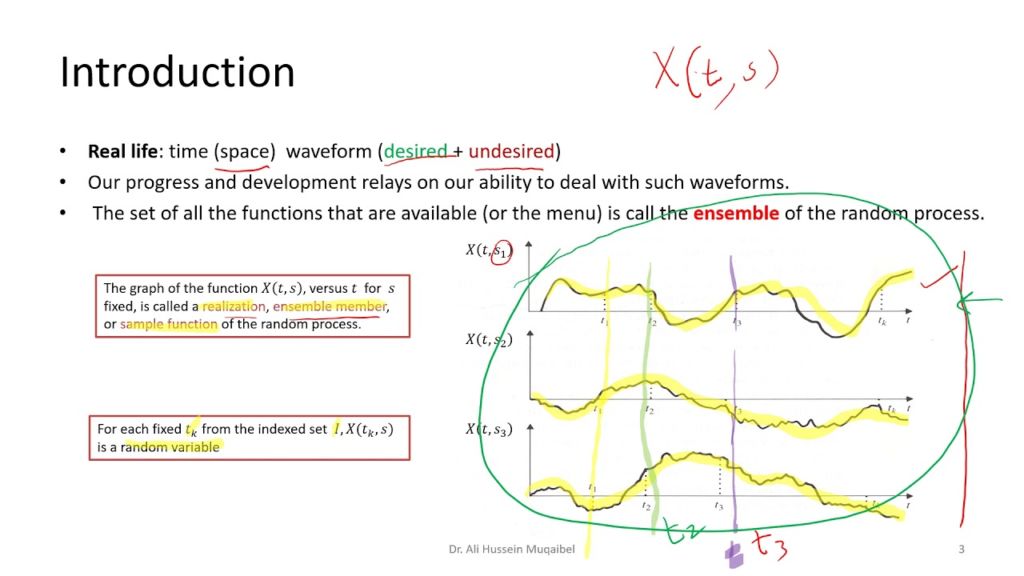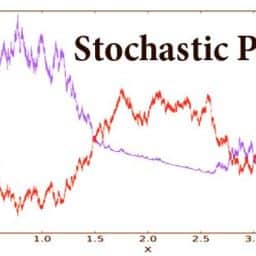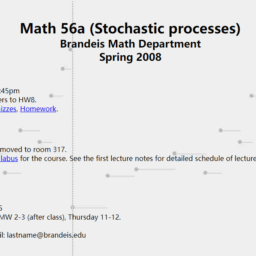MY-ASSIGNMENTEXPERT™可以为您提供brandeis.edu Math56a Stochastic Porcesses随机过程课程的代写代考和辅导服务!
这是布兰戴斯大学 随机过程课程的代写成功案例。

Math56a 课程简介
A stochastic process is a random process which evolves with time. The basic model is the Markov chain. This is a set of “states” together with transition probabilities from one state to another. For example, in simple epidemic models there are only two states: $S=$ “susceptible” and $I=$ “infected.” The probability of going from $S$ to $I$ increases with the size of $I$. In the simplest model The $S \rightarrow I$ probability is proportional to $I$, the $I \rightarrow S$ probability is constant and time is discrete (for example, events happen only once per day). In the corresponding deterministic model we would have a “difference equation.”
Prerequisites
In a continuous time Markov chain, transition events can occur at any time with a certain probability density. The corresponding deterministic model is a first order differential equation. This includes the “general stochastic epidemic.”
The number of states in a Markov chain is either finite or countably infinite. When the collection of states becomes a continuum, e.g., the price of a stock option, we no longer have a “Markov chain.” We have a more general stochastic process. Under very general conditions we obtain a Wiener process, also known as Brownian motion. The mathematics of hedging implies that stock options should be priced as if they are exactly given by this process. Ito’s formula explains how to calculate (or try to calculate) stochastic integrals which give the long term expected values for a Wiener process.
Math56a Stochastic Porcesses HELP(EXAM HELP, ONLINE TUTOR)
Find the function $f(n), n=0,1,2,3, \cdots$ so that $f(0)=0$
$$
\begin{gathered}
f(n)=\frac{1}{3}[f(n-1)+f(n+1)+f(n+2)], \quad n \geq 1 \
\lim {n \rightarrow \infty} f(n)=1 . \end{gathered} $$ The general solutions are $f(n)=c^n$ where $c$ is a solution of $$ c^3+c^2-3 c+1=0 $$ After factoring: $$ c^3+c^2-3 c+1=(c-1)\left(c^2+2 c-1\right) . $$ So, $c=1,-1 \pm \sqrt{2}$. The general solution is: $$ f(n)=A+B(-1+\sqrt{2})^n+C(-1-\sqrt{2})^n $$ The condition $f(0)=0$ implies that $$ A+B+C=0 $$ Since $\lim {n \rightarrow \infty} f(n)=1$ it also follows that
$$
\lim {n \rightarrow \infty} f(2 n)=1 $$ but, $$ \lim {n \rightarrow \infty}(-1-\sqrt{2})^{2 n}=\infty
$$
since $|-1-\sqrt{2}|>1$ and
$$
\lim {n \rightarrow \infty}(-1+\sqrt{2})^{2 n}=0 $$ since $|-1+\sqrt{2}|<1$. Therefore, in order to have $\lim {n \rightarrow \infty} f(n)=1$, we must have $C=0$ and $A=1$. So, $B=-1$ and
$$
f(n)=1-(-1+\sqrt{2})^n
$$
A man is playing two slot machines (call them $A$ and $B$ ). Machine $A$ gives a payoff with a probability of $1 / 6$ and machine $B$ gives a payoff with probability $1 / 16$. The man starts by picking a machine at random. Then he plays the machine until he has lost twice (not in a row, just in total). Then he switches machines and continues. For example, suppose that his winning (1) and losing (0) sequence might be:
$$
{ }0 1_1 0_2 0_3 1_4 0_5 1_6 0_7 1_8 0_9 1{10} 0_{11} 0_{12}
$$
Then he will switch machines after $n=2$ since he lost twice. (He switches in the time between $n=2$ and $n=3$ ). He switches back after $n=6$ and then again after $n=10$.
(a) Make this into a Markov chain with 4 states: $A_0, A_1, B_0, B_1$ where the subscript keeps track of the number of losses. [This is an example of recording information to convert a stochastic process to first order.]
(b) What is the probability that the man will be playing machine $A$ at $n=4$ if he starts at machine $A$ ? What about if he starts at a machine picked at random?
(c) Find the invariant distribution.
(d) In the long run, how much of the time will the man be playing the better machine?
Suppose that
$$
P=\left(\begin{array}{cccc}
0 & 0 & 0 & 1 \
0 & 0 & 1 & 0 \
.4 & .4 & 0 & .2 \
.7 & 0 & 0 & .3
\end{array}\right)
$$
(a) Find the unique invariant distribution and explain why it is unique.
(b) Draw the diagram and find the communication classes.
(c) What is the probability that $X_{100}$ is in the transient class given that you start in the transient class? What about if you start at a random location?
Example: We have 4 factories:
$$
\begin{aligned}
& S=\text { Steel } \
& W=\text { Water } \
& E=\text { Coal/Gas/Oil } \
& P=\text { Plastic }
\end{aligned}
$$
To produce $\$ 1$ worth of steel, the steel factory needs $50 \&$ worth of energy and $25 \phi$ worth of water (and no plastic). This goes into the matrix $Q$ in the first line.
$$
Q=\left(\begin{array}{cccc}
0 & .25 & .5 & 0 \
.1 & 0 & .4 & .2 \
.2 & .1 & .3 & .1 \
.1 & .2 & .2 & .1
\end{array}\right)
$$
Each factory keeps a stockpile of material, say $10 \$$ worth of each item. When it get an order for goods, the factory uses its inventory and then orders replacements. So, the steel factory, after filling out an order for $1 \$$ worth of steel will order $25 \&$ worth of water and $50 \notin$ worth of energy.
(*) Write in words: What do the numbers in the fourth row of the matrix mean?
The consumer wants $1 \$$ of steel, $2 \$$ of water, $10 \$$ of energy and $2 \$$ of plastic.
(a) How much does each factory need to make?
(b) Follow the money: Where do the $15 \$$ go after 4 rounds?
(c) How long does it take for all factories to regain $99 \%$ of their original inventory assuming that they keep $10 \$$ worth of each commodity in stock.
(d) Follow the energy. Take the total amount of energy (your answer to part (a)) that is

MY-ASSIGNMENTEXPERT™可以为您提供BRANDEIS.EDU MATH56A STOCHASTIC PORCESSES随机过程课程的代写代考和辅导服务!




